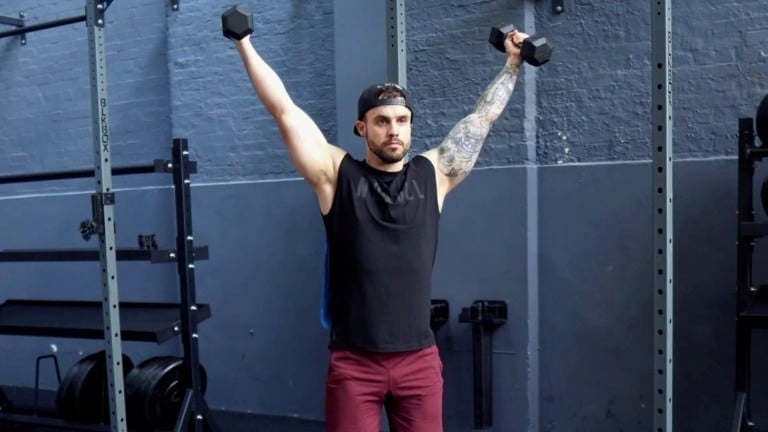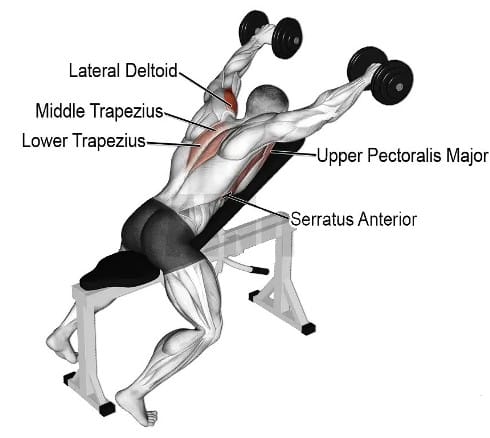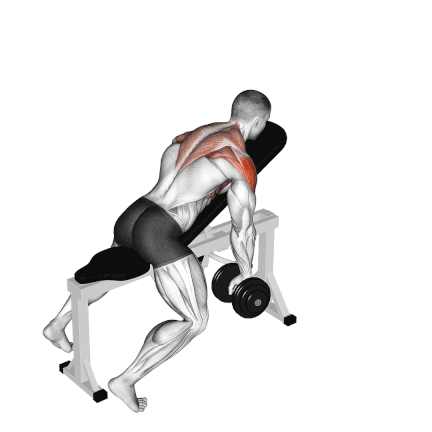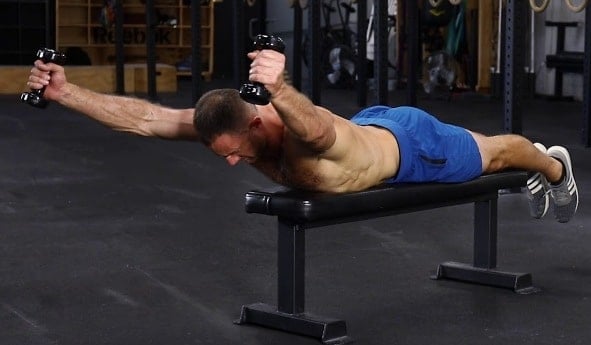The dumbbell Y raise is a beneficial workout that works your shoulders and upper back muscles, including the rear deltoids and traps. It not only targets specific muscle groups but also improves shoulder stability, and posture.
And the best part? Dumbbell Y raises can easily be done at home with just a set of dumbbells.
It gets its name from the shape your arms make during the movement, which looks like the letter Y.
Dumbbell y raises can be performed using different angles, equipment, or movements to improve workouts, challenge muscles, meet different needs, break plateaus, and yield better results.

- Dumbbell Y Raise Muscles Worked
- 1. Standing Dumbbell Y Raise
- How To Do Standing Y Raise
- Tips
- 2. Incline Dumbbell Y-Raise
- How To Do Chest-Supported Dumbbell Y Raise
- 3. Dumbbell Floor Y Raise
- How to Do Dumbbell Floor Y Raise
- 4. Bent-Over Dumbbell Y Raise
- How to Do Bent-Over Dumbbell Y Raise
- Tips
- Dumbbell Y Raise Alternatives
- Takeaways
Dumbbell Y Raise Muscles Worked
The Dumbbell Y Raise primarily targets the shoulders and upper back
- Lateral deltoid (at the side)
- Posterior deltoid (behind)
- The upper trap,
- Middle trap, and
Other upper back muscles worked during the exercise.
- The anterior deltoid (In front)
- Lower trapezius muscles
- Rhomboids
The dumbbell Y raise indirectly works the rotator cuff muscles and core muscles during the standing raise.

1. Standing Dumbbell Y Raise
The standing Y raise is easy to do at home without a bench, and it is similar to movements in everyday activities, sports, and athletic performance.
The standing Y raise simultaneously targets the deltoids, trapezius, and rhomboids, which provide a comprehensive shoulder workout.
How To Do Standing Y Raise
- Stand with feet shoulder-width apart, holding dumbbells with palms facing inward.
- Lift the dumbbells diagonally out to the sides and upwards, forming a “Y” shape with your arms.
- Keep a slight bend in the elbows and focus on contracting the shoulder muscles.
- Squeeze the shoulder blades together at the top of the movement.
- Lower the dumbbells back to the starting position with control.
Tips
- Start with lighter weights and gradually increase resistance as you progress.
- Maintain proper posture with a neutral spine and engaged core.
- Focus on the mind-muscle connection and contract the muscles you want to work on.
- The exercise should be performed at a slow and controlled pace.
- Be careful not to put too much weight on your deltoids, as it is easy to injure them.
Know More: Best Dumbbell Shoulder Exercises For Mass
2. Incline Dumbbell Y-Raise
Incline Y dumbbell raises are a great and easy-to-do shoulder stability exercise that targets both the rotator cuff muscles and your mid and lower traps.
Although the Y Raise is commonly performed on an incline bench, it can be modified to suit your needs and performed in various ways: standing, on the floor, flat or even a Swiss ball.
Some other names for the incline dumbbell Y are:
- Chest supported Y raise.
- Prone dumbbell Y raise.
- Incline Y delt raise

How To Do Chest-Supported Dumbbell Y Raise
- Lie face down on a flat bench with your chin past the end of the bench.
- Hold two light dumbbells or weight plates.
- Lift both dumbbells up as high as possible while forming a letter Y with your arms and torso.
- Hold this position for two seconds before returning the dumbbells to the starting position.
- Repeat for the desired number of repetitions.
3. Dumbbell Floor Y Raise
The Dumbbell Floor Y Raise, also known as the supine Y Raise, is a variation of the Y raise exercise performed while lying on the floor.
By eliminating the involvement of the lower body, the focus remains solely on the shoulder and upper back muscles.

How to Do Dumbbell Floor Y Raise
- Lie flat on your stomach on the floor or on a bench with your legs extended. Keep your neck relaxed.
- Hold dumbbells with your arms facing inward.
- Lift the dumbbells diagonally out to the sides and upwards, forming a Y shape with your arms.
- At the top of the movement, focus on contracting the shoulder muscles and pulling the shoulder blades together.
- Slowly lower the dumbbells back to the starting position with control.
4. Bent-Over Dumbbell Y Raise
The bent-over dumbbell Y raise is a fantastic exercise that takes dumbbell raises to the next level. It not only targets your shoulders but also challenges your core.
A significant core engagement is required to maintain stability throughout the bent-over position.

How to Do Bent-Over Dumbbell Y Raise
- Hold dumbbells in each hand and stand with your feet hip-width apart.
- Hinge forward at the hips and keep your back flat and knees bent.
- Let your arms hang down naturally toward the floor, with a little bend at the elbows.
- Lift the dumbbells out to the sides and up in a Y shape with your arms.
- Squeeze your shoulder blades together at the top of the movement.
- Slowly lower the dumbbells back to the starting position with control.
Tips
- Maintain a strong and stable core by engaging your abdominal muscles.
- Avoiding back arching or rounding too much.
- Always breathe out when you lift and inhale when you lower it.
Know More: 21 Bodyweight Shoulder Exercises: Beginner to Advance
Dumbbell Y Raise Alternatives
Here are some alternatives to the Y raise exercise for those who want to change up their shoulder workout:
- T Raise: You can make a “T” shape with your body by raising your arms out in front of you instead of raising them to the sides.
- W Raise: Instead of extending your arms to the sides, raise them at a 45-degree angle to form a “W” shape with your body.
- L Raise: Create an L-shaped shape with your body instead of doing a Y raise.
Takeaways
Y raise is a time-efficient shoulder exercise that’s also good for your posture and joint health. It would be a good addition to your shoulder workout library.
References
- Kim, Eunkuk & Kim, Jinho & You, Jinyoung. (2020). Effects of Lower Trapezius Strengthening Exercise on Shoulder Pain, Function and Archery Performance in Elite Archers. The Korean Journal of Sports Medicine. 38. 171-181. 10.5763/kjsm.2020.38.3.171.
- Campos YAC, Vianna JM, Guimarães MP, et al. Different Shoulder Exercises Affect the Activation of Deltoid Portions in Resistance-Trained Individuals. J Hum Kinet. 2020;75:5-14. Published 2020 Oct 31. doi:10.2478/hukin-2020-0033

Manish is a NASM-certified fitness and nutrition coach with over 10 years of experience in weight lifting and fat loss fitness coaching. He specializes in gym-based training and has a lot of knowledge about exercise, lifting technique, biomechanics, and more.
Through “Fit Life Regime,” he generously shares the insights he’s gained over a decade in the field. His goal is to equip others with the knowledge to start their own fitness journey.
